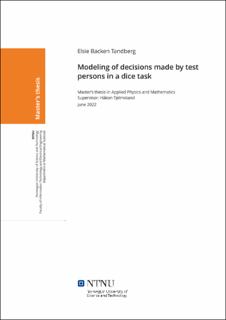| dc.contributor.advisor | Tjelmeland, Håkon | |
| dc.contributor.author | Tandberg, Elsie Backen | |
| dc.date.accessioned | 2022-09-23T17:20:17Z | |
| dc.date.available | 2022-09-23T17:20:17Z | |
| dc.date.issued | 2022 | |
| dc.identifier | no.ntnu:inspera:104646180:36739529 | |
| dc.identifier.uri | https://hdl.handle.net/11250/3021016 | |
| dc.description.abstract | Det er antatt å være en sammenheng mellom å ta forhastede avgjørelser og å være diagnostisert med schizofreni. Noen hevder at oppgaver som omhandler sannsynlighetsresonementer utført av både friske
og schizofrene deltakere, viser denne sammenhengen. Andre mener at
disse oppgavene som tidligere har vært utført, ikke danner et godt nok
grunnalg til å trekke den konklusjonen.
Professor Gerit Pfuhl har laget en alternativ oppgave til de oppgavene som tidligere har blitt brukt til å teste forhasted beslutningstakning hos schizofrene. Denne alternative oppgaven er kalt terningoppgaven og går ut på at man skal identifisere en urettferdig terning
blandt fire terninger. I denne avhandlingen har vi data fra 212 friske og 41 schizofrene deltakere, som har gjennomført terningoppgaven.
Disse dataene vil bli brukt til å betrakte deltakerenes beslutninger, og
å undersøke om det er noen forskjell mellom de to gruppene.
Beslutningene evalueres ved å utlede en sannsynlighetsmodel som
brukes til å regne ut belønninger for hver beslutning. Belønningene
blir så brukt til å tilpasse en stokastisk model til hver deltaker. Den
stokastiske modellen inneholder parametere som estimeres og evalueres
med hensyn på hvorvidt det er mulig å se forskjell på de to gruppene
av deltakere. Fra denne modellen, brukt til å evaluere dataene, kan
vi ikke konkludere med at de schizofrene deltakerene tar annerledes
beslutninger enn de friske deltakerene. | |
| dc.description.abstract | It has been hypothesized that there is a connection between hasty decision making and schizophrenia. Some claim that probabilistic reasoning tasks performed by both healthy controls, and schizophrenic
participants have proven this connection. Others suggest that the
previously performed tasks can not be used to draw the conclusion.
Professor Gerit Pfuhl has made an alternative task to the tasks
previously used to test the hasty decision making in schizophrenic
participants. This alternative task is called the dice task, and the
aim of this task is to identify a loaded die among four dice. In this
thesis we have data from 212 healthy controls and 41 people diagnosed
with schizophrenia who have participated in the dice task. This data
will be used to consider the participants decisions, and to investigate
whether there are any differences between the two groups.
The decisions are evaluated by deriving a probability model used
to calculate rewards for each decision. Next, the rewards are used to
fitting a stochastic model to each participant. The stochastic model
contains parameters which are estimated and studied in order to determine whether it is possible to distinguish the two groups of participants. The findings were that the parameter estimates are similar
for the two groups. Thus, from the particular model presented in
this thesis, used to evaluate the data, we can not conclude that the
schizophrenic participants tend to make different decisions compared
to the healthy controls. | |
| dc.language | eng | |
| dc.publisher | NTNU | |
| dc.title | Modeling of decisions made by test persons in a dice task | |
| dc.type | Master thesis | |
